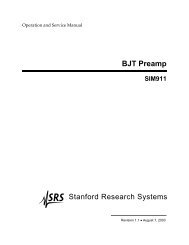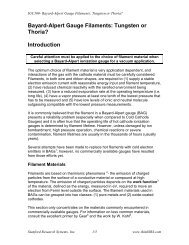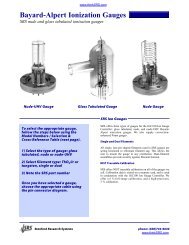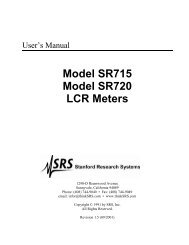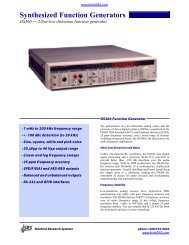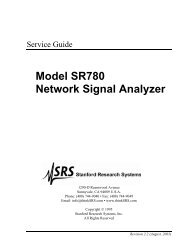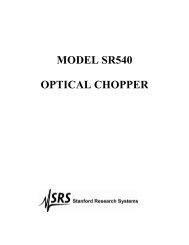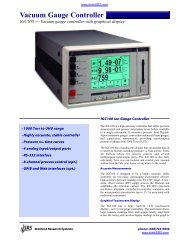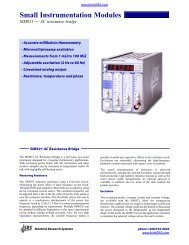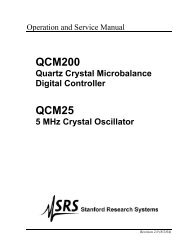Time Interval and Frequency Counter
Time Interval and Frequency Counter
Time Interval and Frequency Counter
Create successful ePaper yourself
Turn your PDF publications into a flip-book with our unique Google optimized e-Paper software.
14 Sample ArmingFREQUENCYThe frequency of either the A or B inputs may bemeasured in this mode of operation. The SR620 isa "reciprocal" frequency counter. That is, itmeasures frequency by measuring the timeinterval for an integer number of cycles of theinput. The frequency is then equal to (number ofcycles)/(Measured <strong>Time</strong>). Since there is nofraction-of-a-cycle error ( as would be seen if theunit merely counted cycles in a fixed gate ) afrequency measurement can be made to 11 digitsof resolution in one second. For frequenciesbetween 0 <strong>and</strong> 200MHz the SR620's front endcomparators may be directly used. Forfrequencies between 200MHz <strong>and</strong> 1.3GHz theUltra High <strong>Frequency</strong> (UHF) prescalers must beused.The number of cycles used in the sample isdetermined by the GATE . The instrument willalways measure at least 1 period of the input.Gates from 1ms to 500s, or EXTernal gates maybe selected from the front panel. The actual gatetime for the internal gates is the gate time set onthe front panel multiplied by the "gate scale" set inthe configuration menu. Thus if one desired a 20sgate one would set the gate scale to 200 <strong>and</strong> thegate time to 0.1s (0.1s x 200 = 20s). If the "gatescale" is not set to the default of 1 the gate timeled on the front panel will blink. Due to internalsynchronization circuitry, the frequencymeasurement starts on the 2nd input edge afterthe gate opens <strong>and</strong> ends on the second inputedge after the gate closes. Thus, a frequencymeasurement always requires at least 2 completecycles of the input waveform.The choice of GATE mode is determined mainlyby the desired resolution <strong>and</strong> measurementspeed. A longer gate results in a higher resolutionmeasurement with 11 digits obtainable in a onesecond sample. The SR620 always adjusts thenumber of displayed digits to reflect theappropriate resolution depending on gate time.The accuracy of frequency measurements isdetermined by the accuracy of time intervalmeasurements. For very short gates, theaccuracy is determined by the 200ps time intervalaccuracy, while for long gates the accuracy islimited by the accuracy of the timebase.EXTERNAL gates may be applied to the EXTinput <strong>and</strong> may range from 5ns to 1000s, althoughthe SR620 always measures for at least 1 inputperiod regardless of the gate time. The setup timefor an external gate is about 10 ns. Additionally,the EXT input may be used to trigger any of theinternal gates (in this mode both the "ext" <strong>and</strong> thegate time LED will be on). This is useful , forexample, to synchronize a 0.1s gate to an externalevent. Additionally, gates of 1 us to 10 ms maybe scanned using the SR620's scanning facility.These gates must be externally triggered. Thegate may either be fixed in time relative to the EXTinput, or may be automatically scanned at the endof a measurement of N samples. If scanned, thestep size is equal to the gate width <strong>and</strong> the initialdelay may be set between 1 <strong>and</strong> 50000 gatestimes. This scanning ability allows one to makemeasurements of frequency as a function of timefrom some event, such as the time response of aVCO to a step change in control voltage.The RATIO of the frequencies of two inputs will bedisplayed if both the A & B source LED are on. Itshould be noted that the A <strong>and</strong> B frequencies arenot measured simultaneously but are measuredon alternate measurement cycles.PERIODPeriod measurements are done virtually the sameway as frequency measurements, however thereciprocal of the frequency is reported instead ofthe frequency. Gating modes are identical tothose used in the frequency mode.When both the A <strong>and</strong> B source lights are on, theratio of the periods of signals applied to the A <strong>and</strong>B inputs may be displayed. Period ratios may spanfrom 10-9 to 10+3.PHASEThe phase between the A <strong>and</strong> B inputs ismeasured in this mode of operation. Twomeasurements are actually being done: the periodof the A input <strong>and</strong> the time interval between the A<strong>and</strong> B inputs. For example, suppose the A <strong>and</strong> Binputs are both 1 KHz square waves (1000usperiod) with the rising edge of B coming 250usafter the rising edge of A. The unit would measureSR620 Universal <strong>Time</strong> <strong>Interval</strong> <strong>Counter</strong>



